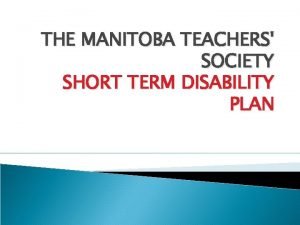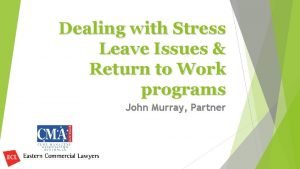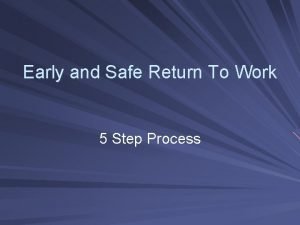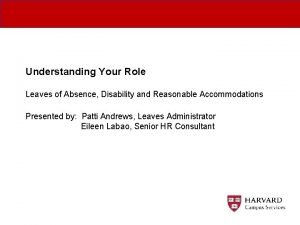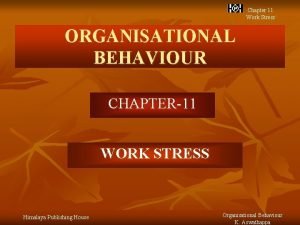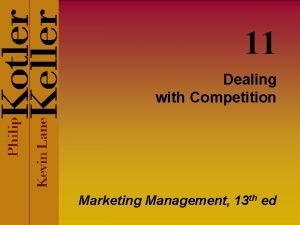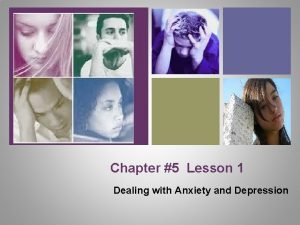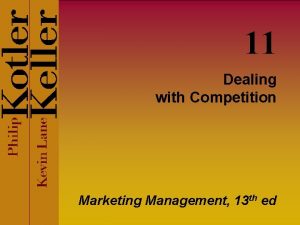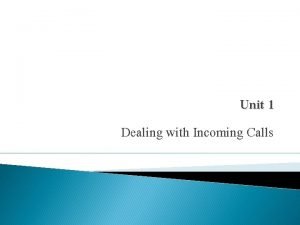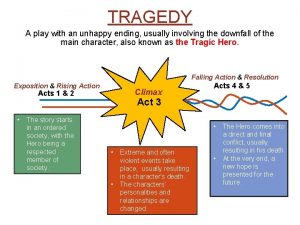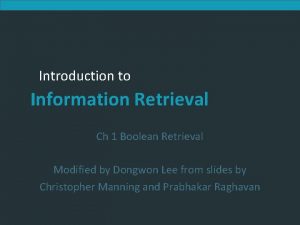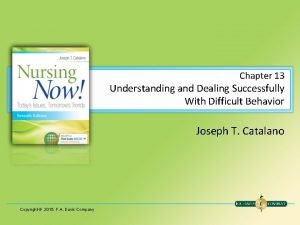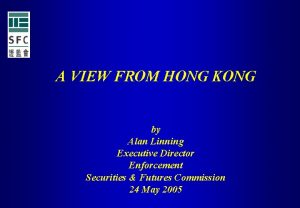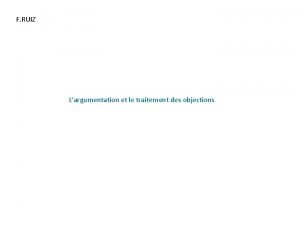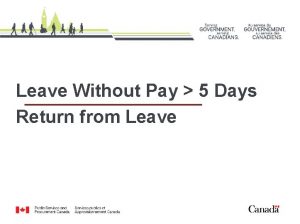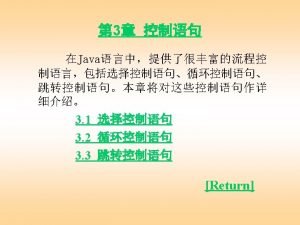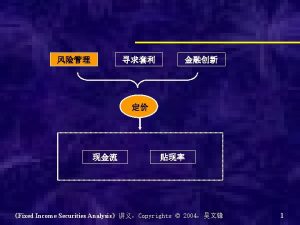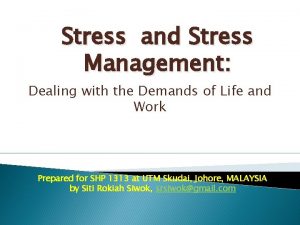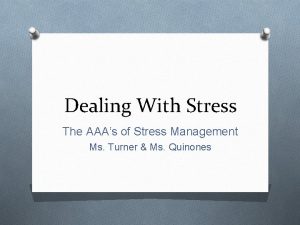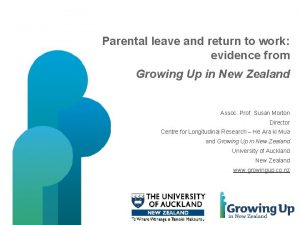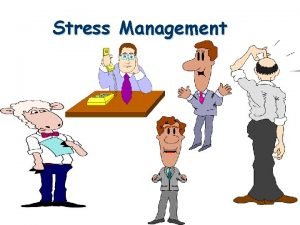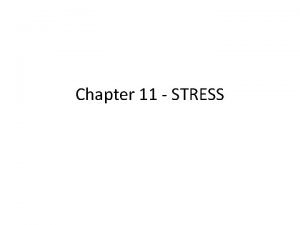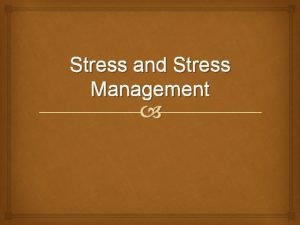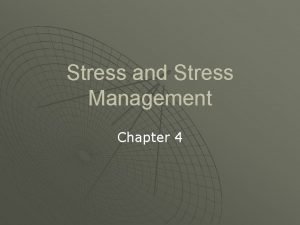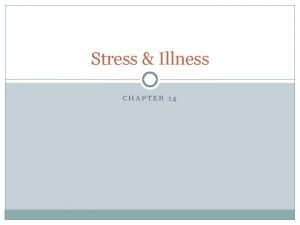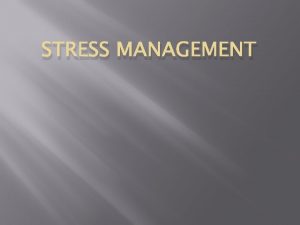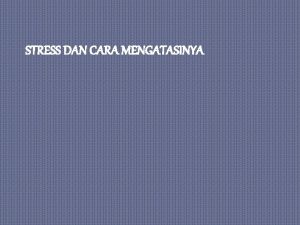Dealing with Stress Leave Issues Return to Work




































- Slides: 36

Dealing with Stress Leave Issues & Return to Work programs John Murray, Partner

Introduction Costs of stress claims at work Adverse effects on organisational performance Relevant Legislation in NSW and Qld for Psychological Injury and Return to work Definitions of stress and psychological injury – is stress compensable ? Seven key elements for early intervention in order to prevent psychological injury Symptoms from exposure to workplace stress Causes of workplace stress/strategies to eliminate or control Case Study Return to work obligations for NSW Return to work obligations for Qld Risks for Clubs associated with Return to work programs Rehabilitation and Return to work in context of Psychological injury Provision of suitable duties upon return to work Follow up

Costs of Stress Claims at Work-related stress is the second most common compensated illness/injury in Australia, after musculoskeletal disorders. The total economic cost of work related injury to the Australian economy was estimated to be $61. 8 billion in the 2012 -13 reference year (Australian Bureau of Statistics, Work Related Injuries Survey ‘WRIS’). This had almost doubled in just over ten years from the 2000 -01 financial year being $34. 3 billion. The most recent figures from the 2013 -14 period indicate that 61% of people who experienced a workrelated injury were males. Significant adverse effects on organisational performance. The most common work-related causes of “stress” include but are not limited to: § Organisational culture and management practices; § Physical work environment and trauma; § Change management and role conflict.

Relevant Legislation Workers Compensation Act 1987 (NSW) Workplace Injury Management and Workers Compensation Act 1998 (NSW) Workers Compensation Regulation 2016 (NSW) SIRA “Guidelines for workplace Return to Work programs 2016” (NSW) Workers Compensation and Rehabilitation Act 2003 (Qld) Workers Compensation and Rehabilitation Regulation 2014 (Qld) Guidelines for standard for rehabilitation (Qld)

Stress – is it compensable ? Stress –dictionary defined as “a state of mental or emotional strain or tension resulting from adverse or demanding circumstances”. Stress is not necessarily a compensable injury under workers compensation legislation Distinction between “stress” and psychological, psychiatric and physiological injuries “Psychological injury” refers to a range of cognitive, emotional and behavioural symptoms that interfere with a worker’s life and can significantly affect how they feel, think, behave and interact with others E. g. depression, Post Traumatic stress disorder, other anxiety and adjustment disorders

Stress – is it compensable? Injury is defined in the WC Act (NSW) in s. 4 as “a personal injury arising out of or in the course of employment …” S. 11 A (3) defines “psychological injury” as “an injury(as defined in section 4) that is a Psychological or Psychiatric disorder. The term extends to include the physiological effect of such a disorder on the nervous system. ” S. 11 A(7) prohibits use of the words “stress” or “stress condition” for describing the workers condition – must use acceptable medical terminology in any medical certificate supporting absence from work. However, s. 11 A provides that “No compensation is payable under this Act in respect of an injury that is a psychological injury if the injury was wholly or predominantly caused by reasonable action taken or proposed to be taken by or on behalf of the employer with respect to transfer, demotion, promotion, performance appraisal, discipline, retrenchment or dismissal of workers or provision of employment benefits to workers. ……. ”

Stress -is it compensable ? S. 32 of the WC & R Act (Qld) defines meaning of injury as follows: (1) An Injury is a personal injury arising out of, or in the course of, employment if: (a) for an injury other than a psychiatric or psychological disorder – the employment is a significant contributing factor to the injury; or (b) for a psychiatric or psychological disorder – the employment is the major significant contributing factor to the injury (3) Injury includes the aggravation of a psychiatric or psychological disorder. (5) Despite subsections (1) and (3), injury does not include a psychiatric or psychological disorder arising out of, or in the course of, any of the following circumstances(a) reasonable management action taken in a reasonable way by the employer in connection with the worker’s employment; (b) the worker’s expectation or perception of reasonable management action being taken against the worker; (c) action by the Regulator or an insurer in connection with the worker’s application for compensation

Seven key elements for early intervention in order to prevent psychological injury Develop policy/procedures on how to support employees exhibiting early warning signs. The policy should state support is provided regardless of whether a claim has been submitted or not Duty manager/Supervisor awareness of the early warning signs, and how to respond appropriately (achieved through training, policy and guidance material) Early contact with the employee to offer assistance/if employee safety or self harm is a concern/contact should be made with senior management immediately to arrange appropriate counselling Early and expert assessment/medical treatment if necessary to identify employees needs Employee and supervisor involvement in developing agreed plan to return to work (if possible) Access to effective medical treatment and evidence based therapeutic interventions if there is a psychological condition Flexible workplace solutions to support the individual at work upon return to work.

Symptoms from exposure to work – related stress Unresolved stress leading to psychological and/or physiological changes can be detected by looking for the following signs: Physical – head aches, tiredness, reduced reaction time, shortness of breath, weight loss or gain, dishevelled appearance, rashes, gastro – intestinal disorders Mental – indecisiveness, memory loss, lack of concentration, loss of confidence, Behavioural – diminished performance, withdrawal from colleagues, erratic behaviours, emotional responses, complaints of lack of management support, fixation with perceived unfairness, complaints of not coping with workload, reduced participation, increased consumption of alcohol, cigarettes, caffeine and/or sedatives, unplanned absences, conflict with other staff, increased errors Emotional – irritability, excess worrying, feeling of worthlessness, anxiety, defensiveness, anger, mood swings All symptoms if left unresolved can lead to more serious psychological/ psychiatric illness

Causes of Stress and Strategies to eliminate or control Element Work environment/trauma Problem Strategy - inadequate resources and equipment - poor working conditions - noise, temperature, air quality - general unresolved safety issues - a workplace accident or risk that remains unresolved Manager must: - allocate adequate resources to ensure safety - consult with employees in order to make aware of/fix any concern - provide information, instructions, supervision and training.

Causes of Stress and Strategies to eliminate or control Element Work Organisation Problem Strategy - workflow issues ie bottlenecks, shortcuts, breaches of rules and procedures, errors that are not corrected - unsatisfactory management and supervision of inexperienced staff - lack of planning ie peak time/excessive work load. - job redesign - ensure review and management of workflow at peak times - reinforcing rules and procedures - raise matters directly with employees/counsel and give directives to employees as to the area where improvement is required

Causes of Stress and Strategies to eliminate or control Element Employment conditions Problem Strategy - excessive workload - Unreasonable expectations from Board on Management - work/life balance issues - job description mismatched with employee’s capacity - insufficient remuneration, recognition and reward - no annual leave or sick leave - No control over outcomes/lack of support - managers/Boards need to review business/consult to identify these problems - review of business performance to determine whether change in employment conditions warranted- ie. increase in staff or remuneration - make reasonable adjustments to positions accommodate staff - have policies addressing leave entitlements

Causes of Stress and Strategies to eliminate or control Element Recruitment/selection issues Problem - mismatch of job and employee - job ‘oversold’ at recruitment/advertising stage - eg. Misleading title or misrepresenting opportunities for advancement - employee over qualified/bored - employee oversells experience Strategy - review of recruitment process and procedures - need induction - training/retraining staff with recruitment - obtain new provider - look at possible transfer/career progression - training - job re design - alternative of performance management

Causes of Stress and Strategies to eliminate or control Element Promotion Problem - employee promoted beyond his/her ability/too soon - promoted into an unwanted or unsuitable role ie has finance skills but no people skills Strategy - managers should be proactive in performance management - provide support and resources/mentoring to avoid or overcome problem - conduct annual review/set goals for following year - reward performance

Causes of Stress and Strategies to eliminate or control Element Job role/communication from management Problem Strategy - job role may be unclear/lack of clarity - conflict over who has responsibility - issue with communication style - job tasks not properly communicated - job descriptionresponsibilities needs to be clearly set out - consider whether your communication style is appropriate for nature of workforce - need to afford fairness in resolution of conflict/organisational justice

Causes of Stress and Strategies to eliminate or control Element External factors/outside work pressures Problem Strategy - performance deteriorates after having been satisfactory - behavioural and conduct problems arising - managers must distinguish between external factors v’s organisational causes - if later, management must take immediate steps to resolve - if former, management should attempt to arrange employee counselling /assistance in order to assist - takes steps to mitigate against claims of work related stress/inaction/unreasona bleness)

Causes of Stress and Strategies to eliminate or control Element Work Group/peer group problems Problem Strategy - personality clashes - harassment/bullying - conflict between job requirements and cultural values - work hoarding - poor management of staff - wide variety of problems both individual and group related - managers should identify the problems and formulate the appropriate solution in consultation with HR - arrange transfers - redesign jobs - counselling - team building - independent mediation - afford fairness

Case Study Dominos driver claims psychological injury after missing out on $15, 000 employee of the year award Employee claims she was 'psychologically injured' after losing the pizza-chain’s 2016 Delivery Driver of the Year competition. In 2015, the Employee was awarded the Delivery Driver of the Year prize, having achieved the highest overall performance score of the 15, 000 other drivers throughout Australia and New Zealand. Her prize was a brand new car. Throughout the year, drivers can follow their progressive performance and rankings against other drivers. However, in May 2016, the Employee noticed her ranking on the leader board had slipped by around 100 places. Consequently, she made a number of complaints to Head Office about her concerns that the GPS system was inaccurately displaying efficiency scores. She claimed her complaints were ignored until it was too late to affect the 2016 results. As it turned out, the 2016 prize was awarded to another driver and he received the $15, 000 cash prize. The Employee believed not only that the GPS system inaccurately calculated efficiency scores, but also that the driver who won the award was not eligible to enter the competition because he was a cyclist and not a driver and he did not work the full year, but only commenced in May 2016. Domino's conducted multiple internal reviews of the collected data, all of which confirmed that the data and calculations were accurate and consistently applied to all drivers. In fact, the main reason why the Employee did not win first prize, was not the GPS calculations, but the lower customer feedback scores she had achieved compared to the winner, claimed Domino’s. The FWC dismissed the Employee’s application, finding that it did not have the jurisdiction to deal with the matter. Moreover, the Employee lodged a workers' compensation claim, alleging she suffered from a psychological injury in a direct response to the circumstances leading to her failure to win first prize in the 2016 bonus competition. The claim was rejected by the insurer on the basis the actions of her employer were reasonable. The decision is under review.

Responsibility to ensure a Return to work plan is in place In NSW, Insurer is responsible for development of an injury management plan As part of guidelines, Employer is responsible for development of Return to Work plan Applicable if employee is away from work for more than 7 days If injury is a significant injury, then insurer must establish an injury management plan In Qld, insurer is responsible for ensuring that a return to work plan is in place Insurer must take steps it considers practicable to coordinate the development and maintenance of a rehabilitation and return to work plan following consultation with injured worker, employer, treating persons Plan needs to outline the rehabilitation objectives and the steps required to achieve the objectives No requirement to have a separate injury management plan for a significant injury

Return to Work obligations for Employers in NSW New laws governing return to work programs in NSW effective from 31 May 2017. SIRA issued ‘Guidelines for Workplace Return to Work Programs’ to take effect. Guidelines are Issued under s. 52 of the 1998 Act and Workers Compensation Regulations 2016. Guidelines operate by force of law as delegated legislation. Guidelines outline best practice for workplace rehabilitation.

Return to Work obligations for Employers in NSW All NSW employers must have a return to work program consistent with the guidelines within 2 years from 31 May 2017 or before. Guidelines define and distinguish between Category 1 and Category 2 employers. Guidelines apply to all workplace rehabilitation and return to work co-ordinator activities and replace September 2010 guidelines. Category 1 Employers meet one of the following criteria: • Employer has a basic tariff premium over 50 K per annum • Employer is Self-insured • Employer is insured by specialised insurer and has over 20 employees Must follow the four activities in the guidelines and comply with the regulations. Category 2 • basic tariff premium of less than 50 K per annum • Insured by a specialised insurer and has under 20 employees Must either adopt SIRA standard return to work program for Category 2 employers or develop own program based on this.

Category 1 Employer – 4 main activities Must implement RTW including 4 main activities: • Appoint a Return to work co-Ordinator • Develop a Return to work program • Consult Workers and Unions • Implement the program

1. Appointment of Return to Work Co. Ordinator (RTWC) RTWC must do the following: • Carry out day to day duties of RTW program. • Must have relevant training, skills and experience to perform the role and functions of RTW co-ordinator. • Employers must retain evidence of the RTW co-ordinators relevant qualifications. • Existing RTW co-ordinators meet the roles training and experience requirements set out in guidelines

1. Appointment of Return to Work Coordinator Duties of RTW coordinator include: • Compiling initial notification information. • Co-ordinating worker recovery/identifying suitable work opportunities. • Preparing, monitoring and reviewing return to work plan • Liaising with external stakeholders such as nominated treating Doctor, insurer, treatment provider, union/workplace relations • Implementing the RTW program • Supporting the redeployment of workers (internally or externally) into suitable employment when the worker cannot return to pre-injury duties • Keeping injury and recovery at work statistics • Keeping confidential case notes/records in line with guidelines • Promoting the health benefits of safework to the workforce • Contributing to the improvement of relevant policies and systems

2. Develop a Return to Work Program Category 1 Employers must ensure the RTW programs cover the following aspects (RTW must be linked to WHS objectives/focus on safety): • Leadership and commitment • Workplace arrangements • Rights and obligations (mutual) After an incident, the RTW program must cover the following areas: • Support for the worker • Recovery at work • Dispute prevention and resolution • Administration

3 and 4 - Consult with Workers and Unions and implementation Employers are required to consult with their workers and any industrial union that represents them when developing any RTW program must explain how the employer meets this requirement Implement a RTW program after consultation phase; • Employer must display and notify the workplace of the RTW program (failing to do so is an offence); • Inform workers of their rights, obligations and the procedures for workplace rehabilitation and recovery at work; • RTW program must have set review dates every 2 years.

Category 2 Employers Are any employer that are not Category 1 employers. All Category 2 employers must have a RTW program in place within 12 months of becoming a category 2 employer. Must consult with workers and union that represents them when developing and reviewing the program. For category 2 RTW, involves 3 main steps: • Appoint the person responsible for recovery at work. • Develop a return to work program. • Implement the return to work program. TIPS Category 2 employers do not need to appoint a RTW co-ordinator (but should appoint someone to manage workers compensation related issues). Category 2 employer can meet their legal obligations by adopting or customising the standard return to work program for category 2 employers. Need to consult workers and union when developing a RTW program ie. through WHS committee Same obligations to inform as Category 1 and to review every 2 years.

Return to Work obligations for Employers in Qld Employers who pay annual wages of more than $7, 124, 520 for the proceeding financial year or that are in a high risk industry with wages of more than $3, 562, 250 must appoint a rehabilitation and return to work Co-Ordinator (RTWC) Clubs not classified as high risk industry hence only larger clubs effected Deregulation - no need for RTWC to be registered to carry out role/no longer need to renew current certificates Responsibility is on the Employer to ascertain whether the RTWC is “appropriately qualified” to carry out the rehabilitation and return to work functions in the workplace Overarching obligation to ensure health, safety and welfare warrants some form of policy within clubs to deal with rehabilitation of workers/return to work

Return to Work Obligations for Employers in Qld An Employer that is required to appoint a rehabilitation and RTWC must also have workplace rehabilitation policy and procedures The policy must be reviewed internally at least every 3 years Employers have six months from the date they fall within the categories to appoint a rehabilitation and RTWC to develop and implement their policy and procedures Workcover Qld website has a template that can assist employers Adherence to Guidelines for standard for rehabilitation (Qld) No requirement to notify regulators of existence of policy

Risks for Clubs associated with Return to Work programs Particular risks arise when an Employee returns to work from an Injury in addition to the risk of re-injury Discipline – Employees have not been held to the requisite notification and evidence requirements for accessing paid (or entitlement to unpaid leave is unclear) Delay – Employees have been allowed to remain on extended unpaid sick leave for too long, without clear expectations on when a final decision concerning their employment will be made Alternatives – Employers have failed to adequately explore reasonable adjustments that could be made to the role to accommodate illness or injury or redeployment Clarity – Employers have failed to clearly set out the employee with Job requirements and whether the modified role is permanent or temporary Medical evidence – Employers have failed to proactively manage the employees capacity to work and seek out medical evidence to support decisions concerning employment – ie stay or go/press medical practitioner for answers/reinjury because badly managed program Lack of communication with stakeholders – need clear line of communication between RTWC, worker, insurer, rehabilitation provider, medical advisers.

Rehabilitation and Return to Work in the context of Psychological injury Prompt notification of injury of a claim initiates the management of a claim and early intervention practices that may assist a worker with Psychological injury Key factors for successful return to work in the instance of Psychological injury are: • Ensuring that workplace psychological hazards are addressed appropriately • Early intervention • An effective workplace –based rehabilitation program and return to work plan • Effective claims management, and • Co-operation, collaboration and consultation between all parties involved. • Generally in all jurisdictions, employers have obligations to consult with the worker and other involved parties, develop or be involved in the development of a return to work plan and provide suitable duties • Over arching responsibility to ensure health, safety and welfare of employees.

Effective Management of Return to Work Ways to ensure effective management of Return to Work: Be satisfied that an employee is fit for return to work via medical evidence Employers can direct employees to attend an independent medical examination in order to test their fitness for work (in the absence of express term in contract or industrial instrument) Consult with worker to identify any potential hazards and eliminate or control those risks upon return to work. Ensure a modified position is suitable Have a return to work program to help injured workers with their recovery and return to work policy to give Managers guidance An employee’s inability to perform the inherent requirements of the position generally would be a valid reason for dismissal subject to legislative compliance (subject to statutory time periods of 6 months in NSW and 12 months in Qld) Employers must allow afford procedural fairness before making any decision concerning employment in terms of inability to carry out inherent requirements

Effective Management of Return to Work Keep in touch with your Employee regularly and enquire regarding estimated recovery times Provide updates or news of the office or work site (where appropriate) Reassure the Employee they are missed and the team is keen for their return. Attempt to include them in any social work gatherings or relevant meetings (if they are able to attend, and once again where appropriate) Address and resolve any outstanding issues that may be a barrier to the Employee returning to work. Advise the Employee what you will do to assist in their return to work and suitable employment to support their return to work

Providing suitable duties Provision of Suitable duties refers to and may involve the following: Suitable duties refers to work that is suited to the workers currently taking into account of their capacity, medical condition, age, skills, work experience and pre- injury employment - see s. 32 A, WC act NSW and s. 4 s WC & R Act (Qld) When the Employee is returning to work their doctor will provide a Certificate of Capacity. Under the legislation, you are required to provide employment that is both suitable and, as far as reasonably practicable, the same as or equivalent to the employment the worker was in at the time of the injury. If you cannot provide or identify suitable work, your insurer can help you with other options Employees are required to co- operate in the rehabilitation process - see s. 47 1998 Act (NSW) and ss 231232 in WC & R Act (Qld) Suitable duties may require the following adjustments: • Flexible working arrangements – varying start and finish times/allowing extra or longer work breaks • Modifying some aspect of the job or work tasks – simplifying tasks, providing greater support- writing down instructions, developing or varying work procedures, allowing people to sit instead of stand • Modifying the work station or work area – relocating the workstation

Follow up Develop a Plan Review compliance with the guidelines If you don’t have a return to work plan - you should have one. SIRA (NSW) has a template where you can develop a plan to assist (as does Workcover Qld) Use respective guidelines which evidence best practise Train Managers to equip with greater capacity to deal with the risk of work related stress injuries and to closely manage.

John Murray Partner Ground Floor, Suite 3, 131 Clarence Street SYDNEY NSW 2000 T: 02 8243 1700 F: 02 9290 1777 E: john. murray@eclawyers. com. au W: www. eclawyers. com. au
 Call center stress syndrome
Call center stress syndrome Stress leave manitoba
Stress leave manitoba Stress leave nsw
Stress leave nsw True fracture strain
True fracture strain Axial normal stress
Axial normal stress Chapter 10 stress responses and stress management
Chapter 10 stress responses and stress management After which activity must food handlers wash their hands?
After which activity must food handlers wash their hands? What is the result of the following vik null ram
What is the result of the following vik null ram Early and safe return to work program
Early and safe return to work program Sample email requesting bereavement leave
Sample email requesting bereavement leave Stress in organisational behaviour
Stress in organisational behaviour Branch of linguistics dealing with meaning
Branch of linguistics dealing with meaning Abiotic factors
Abiotic factors Section 2 dealing with other nations
Section 2 dealing with other nations Market follower
Market follower It is genre of speculative fiction dealing with imaginative
It is genre of speculative fiction dealing with imaginative Chapter 5 lesson 1 dealing with anxiety and depression
Chapter 5 lesson 1 dealing with anxiety and depression Chapter 5 lesson 1 dealing with anxiety and depression
Chapter 5 lesson 1 dealing with anxiety and depression Dealing with competition marketing management
Dealing with competition marketing management Unit 1 dealing with incoming calls
Unit 1 dealing with incoming calls Dealing with anger in the bible
Dealing with anger in the bible Dealing successfully with difficult changes in your life
Dealing successfully with difficult changes in your life Lexical items
Lexical items Referred to a play with an unhappy ending
Referred to a play with an unhappy ending Dealing with unstructured data
Dealing with unstructured data Reuters electronic trading
Reuters electronic trading Dealing with unstructured data
Dealing with unstructured data The branch of zoology dealing with insects
The branch of zoology dealing with insects The branch of zoology dealing with insects
The branch of zoology dealing with insects Dealing with challenging patients
Dealing with challenging patients Dealing successfully with difficult changes
Dealing successfully with difficult changes Dealing with unstructured data
Dealing with unstructured data Insider dealing
Insider dealing Resolve hrs
Resolve hrs 3p fair dealing
3p fair dealing Tied synoynm
Tied synoynm Dealing with objections
Dealing with objections

